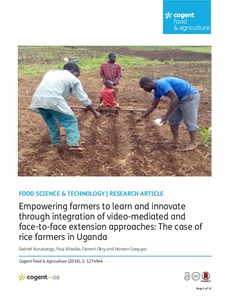| dc.contributor.author | Karubanga, G. |
| dc.contributor.author | Kibwika, P. |
| dc.contributor.author | Okry, F. |
| dc.contributor.author | Sseguya, H. |
| dc.date.accessioned | 2019-12-04T11:04:49Z |
| dc.date.available | 2019-12-04T11:04:49Z |
| dc.date.issued | 2017 |
| dc.identifier.citation | Karubanga, G., Kibwika, P., Okry, F. & Sseguya, H. (2016). Empowering farmers to learn and innovate through integration of video-mediated and face-to-face extension approaches: the case of rice farmers in Uganda. Cogent Food & Agriculture, 1-12. |
| dc.identifier.issn | 2331-1932 |
| dc.identifier.uri | https://hdl.handle.net/20.500.12478/1510 |
| dc.description | Open Access Journal; First Published: 29 December 2016 |
| dc.description.abstract | Agricultural extension is perceived as the primary mechanism through which farmers expand their ability to adopt and adapt new technologies and ideas. The use of Information and Communication Technology like videos in extension is being fronted as an alternative to the conventional Face-to-face extension approach (F2FEA). A comparison of effectiveness of the Video-mediated extension approach (VMEA) and F2FEA among rice farmers in two districts of Uganda challenges the independent use of the two approaches. A cross-sectional survey of two non-equivalent groups subjected to VMEA in Kamwenge and F2FEA in Hoima districts was conducted with 196 farmers. The results indicate greater potential for integration of VMEA and F2FEA as the two are complementary in the various stages of the farmer learning framework developed. VMEA is significantly better in awareness creation and sharing of knowledge and experiences while the F2FEA is significantly better at enhancing knowledge acquisition and retention and application. The relative strengths of VMEA and F2FEA can best be harnessed through integration of the approaches. The integration will not solve the problem of large farmer to extension ratio common in developing countries but will rather make the extension workers more effective. The integration however calls for rethinking of institutional arrangement, roles of the extension worker, and pragmatic retooling of the extension worker to embrace social learning principles that empower farmers to be more self-directed learners and innovators. |
| dc.description.sponsorship | Swiss Agency for Development and Cooperation |
| dc.description.sponsorship | Regional Universities Forum for Capacity Building in Agriculture |
| dc.description.sponsorship | German Academic Exchange Service |
| dc.format.extent | 1-12 |
| dc.language.iso | en |
| dc.subject | Farmers |
| dc.subject | Video-Mediated Extension Approach |
| dc.subject | Face-To-Face Extension Approach |
| dc.subject | Farmer Learning |
| dc.subject | Innovation |
| dc.subject | Rice Production Practices |
| dc.subject | Technologies |
| dc.title | Empowering farmers to learn and innovate through integration of video-mediated and face-to-face extension approaches: the case of rice farmers in Uganda |
| dc.type | Journal Article |
| dc.description.version | Peer Review |
| cg.contributor.crp | Climate Change, Agriculture and Food Security |
| cg.contributor.affiliation | Makerere University |
| cg.contributor.affiliation | National University of Agriculture, Benin |
| cg.contributor.affiliation | International Institute of Tropical Agriculture |
| cg.coverage.region | Africa |
| cg.coverage.region | East Africa |
| cg.coverage.country | Uganda |
| cg.authorship.types | CGIAR and developing country institute |
| cg.iitasubject | Agronomy |
| cg.iitasubject | Farming Systems |
| cg.iitasubject | Knowledge Management |
| cg.iitasubject | Livelihoods |
| cg.journal | Cogent Food & Agriculture |
| cg.howpublished | Formally Published |
| cg.accessibilitystatus | Open Access |
| local.dspaceid | 81628 |
| cg.targetaudience | Scientists |
| cg.identifier.doi | https://dx.doi.org/10.1080/23311932.2016.1274944 |

